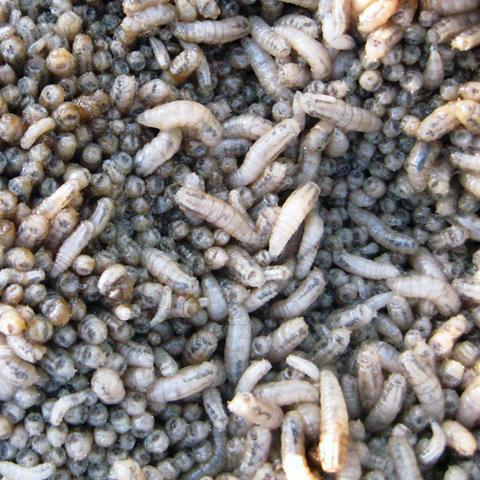Do you work in forensic microbiology, or have an interest in it? Click here to find out about our upcoming AMI event on the topic! This article was originally written and published in 2015. Therefore, certain wording may reflect this.
Entomologists have long applied insect-based information in criminal investigations. Such evidence can be used to help estimate the time of death, if a deceased individual had consumed drugs, if abuse occurred prior to their death, or the remains were moved from one location to another. In examining insect evidence associated with decomposing human or other animal remains, the forensic entomologist is determining the time of insect colonisation to infer a potential time of death.
Historically, this was accomplished by estimating the time needed for insects to develop to the stage (e.g., larva, pupa or adult) at which they were found on the remains. But it turns out that this requires a broader understanding than previously anticipated of the relationship between insect community structure, arthropod development and the decomposition process. What was first thought to be a rather direct relationship, we now know to be much more complicated. A tremendous amount of research is currently being conducted in a variety of settings and locations to explain the biological mechanisms regulating insect attraction, colonisation, and utilisation of human remains. It turns out that microbes play vital roles in this process. For example, microbes serve as symbionts of fly larvae by producing antimicrobial agents that suppress pathogens on vertebrate carrion; and - as mentioned in the previous article - through signalling methods such as quorum sensing to alert flies of the availability of quality resources for their offspring.

Time of colonization of human remains by insects, such as necrophagous flies, can vary. In some instances colonisation can occur prior to, or immediately after death. While in other cases, colonisation could be delayed by hours or even days. We know that there are a number of environmental conditions including rain, temperature, and wind that can affect colonisation. We understand that many biotic factors, such as the classic vertebrate scavenger, the vulture (Figure 4), contribute to this colonisation and decomposition process, but are only now learning that some of the “less visible” biotic factors, e.g. microbes, more specifically bacteria, are key factors in the process.
The utilisation of next-generation genetics has led to novel discoveries associated with microbial diversity, particularly bacteria, associated with decomposing vertebrate remains. For example, research from the Department of Entomology, Texas A&M University has determined the importance of bacterial succession on pig carrion – within the first five days of the animal’s demise. It is estimated that in 62% of cases, the time since death can be explained by the bacterial communities that are present.
Microbes release many of the volatiles associated with the decomposition process, such as indole, dimethyl disulphide, cadaverine, and putrescine, at the time of death or soon thereafter. A number of insects have evolved highly sensitive olfaction systems that allow to them to detect, locate, and evaluate the remains as potential food for their offspring. Such sensitivity gives them survival advantages, as availability of carrion is unpredictable, usually present for only a short period of time (depending on the time of year and location), and highly competed for by other fauna. So if not located quickly, insects miss the opportunity to deposit their offspring in this rich environment.

Furthermore, research is demonstrating that volatiles from microbes could be playing a major role in regulating insect succession (shifts in insect community structure e.g., the number of species present) on vertebrate carrion. More simply put, the odours emitted from microbes on decomposing remains are regulating which insects colonise human remains at different time points after death of the individual. Additionally, necrophagous flies competing for the same remains are attracted or repelled by volatiles released by microbes associated with other species of flies. So the temporal appearance of fly species and their possible deposition of bacterial species onto decomposing remains may ultimately influence the bacterial community structure present. This is significant because such an influence may also affect insect succession during decomposition.
An understanding of the microbial community structure during decomposition could enhance our ability to determine time of death. This information has led to new techniques for estimating the time of death of a person based simply on what insects are arriving at remains at given time points after death. Such approaches are revolutionising the field of forensic entomology, as practitioners are no longer limited to those arthropods feeding on the remains, but can now utilise those insects attracted to the human body and the microbes they interact with to determine time of death. Determining if human remains have been moved from one location to another is also critical for forensic investigations and, microbes could prove to be a critical tool for such purposes.

Presently, we are witnessing the bridging of multiple disciplines within the forensic sciences to better understand how human remains decompose. Entomology and microbiology serve as a model of how such collaborations result in advancements, and applications, vital to solving crime globally; however, many challenges still remain partially due to the breakneck speed at which high-throughput technologies are improving. In particular, the validity of these techniques for determining forensically relevant information, database limitations (e.g., many microbial species have yet to be classified), experts able to bridge computer science, microbiology and entomology within an ecological and forensic context, and most importantly government or private support for continued research. With continued support from granting agencies throughout the world, such limitations can be addressed resulting in scientifically validated techniques and associated analysis of forensic evidence for use in a court of law.








No comments yet